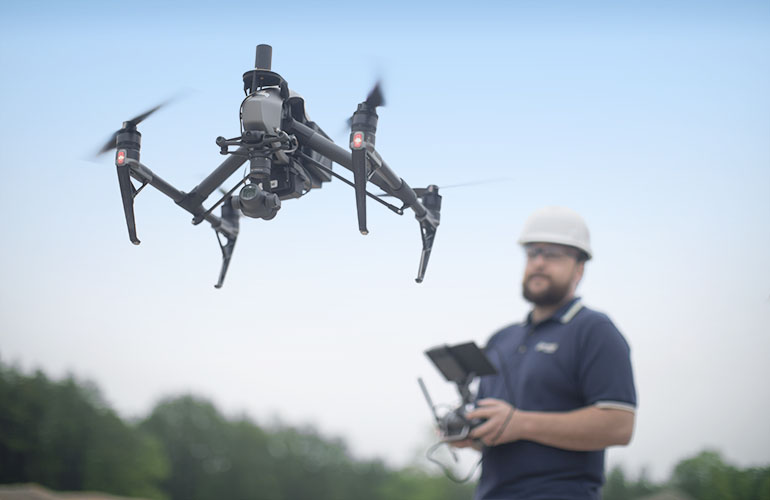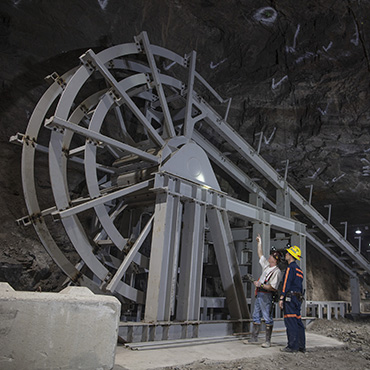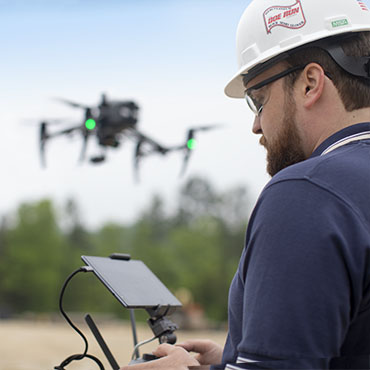Equipping the Mine of the Future
16 Aug 2019

Technology helps people do their jobs better, faster and safer. Mining is no exception. In 2018, we piloted three technologies that increase mine production and improve safety.
“Doe Run and our predecessors have always been known for innovation, whether we come up with a novel idea or use existing technology in a new way,” said Clay McNail, superintendent, Fletcher and Sweetwater Mines. “To stay competitive, we continuously examine how to reduce costs while increasing productivity.”
Miners who first worked the Viburnum Trend in the 1960s would be amazed to see the technologies transforming how we work. In many cases, Doe Run is one of the first companies to pilot these innovations, which keeps our business competitive and helps attract the next generation of employees.
Brian Mangogna, general manager – SEMO operations
Rail-Veyor

In 2018, our Casteel Mine became the first mine in the United States, and only the second commercial operation in the world, to install the Rail-Veyor continuous rail hauling system. The Rail-Veyor system operates like an underground electric light rail system. The fully automated system currently transports ore over three miles underground and can be expanded further if necessary.
“This technology has the potential to revolutionize underground mining,” said Steve Dismuke, technical services superintendent at Buick Mill, and project manager for Rail-Veyor. “As an early adopter of the system, this can provide us with efficiencies that other companies don’t have. We expect other companies will want to come and see our rail in operation.”
Previously, a hoist system at Casteel Mine brought ore to the surface, where it was trucked by road to be processed at Buick Mill. The hoist system operated at a maximum capacity of 3,600 tons of ore each day, which gave us no room to increase production in this mine. Now that we can load rail cars on a continuous loop, we can transport 800 tons more ore to the mill each day, and still have the hoist system as a backup option.
“One of the added benefits of Rail-Veyor is that it will reduce traffic on community roads,” said Steve. “The train will replace 200 one-way haul truck trips each day.”
Rail-Veyor requires only one operator to start and monitor the system. The operator uses a series of cameras to observe the rail system in real time from any location with an internet connection. This enables the operator to quickly identify potential issues or maintenance requirements. Employees who previously worked on the loaders and hoist system now operate Rail-Veyor or hold other underground jobs, giving them new opportunities and helping maximize production. Rail-Veyor is expected to provide strong savings year over year.
Flying High with Drones

From flying several hundred feet above ground to nearly 1,000 feet below ground, camera-equipped drones are changing the way we operate. In 2018, we purchased two drones after a team of employees in information technology, environmental management and operations tested the technology and made the business case for several applications.
“Drones are particularly helpful in conducting inspections in hard-to-reach places. With a drone, I’m able to view all sides of our 550-foot emissions stack in a matter of minutes while remaining safely on the ground,” said David Boren, operations technology analyst at Doe Run. “In the past, this would have taken hours, and required riding an elevator 300 feet and climbing a ladder beyond that point.”
David has also flown a separate drone deep underground, where it can collect data and imagery in mining areas unsafe for human exploration, such as large open areas no longer supported by pillars. Flying a drone underground has its challenges because GPS does not function underground, so drone pilots must remain in visual contact with the drone. We use a smaller, lightweight drone in the mines (about three pounds), which can be more vulnerable to air currents.
Back on the surface, we use a heavy-duty eight-pound drone with a high-definition camera and GPS in conjunction with a surface survey kit and specialized software to estimate volume in stockpiles of metal concentrates, generate topographic images and calculate topography changes between flights.
“Drones have helped us reduce risk and time to carry out common tasks,” added Gen Sutton, environmental, health and safety (EHS) technical supervisor and drone pilot. “We can safely view mine tailing dams, roofs, ductwork, and practically any location on land or in our mines that could potentially expose employees to hazards, in a fraction of the time while obtaining views we were previously unable to see.”
Technology is, and will continue to be, one of the largest contributors to Doe Run’s success. From exploration to transportation to mineral processing and recovery, technology is deeply ingrained in our day to day operations.
David Boren, operations technology analyst
FARA: Field Analysis and Reporting Application
The same sort of technology that gives you remote control and monitoring at home is changing the way we work underground. Innovative software and sensors are revolutionizing how we understand and manage information at our mines in real time.
Our Fletcher Mine is the first underground mine in the world to pilot the Field Analysis and Reporting Application (FARA) for data collection and analysis. FARA is a fleet and personnel management system designed for mines, quarries and construction sites to give supervisors immediate insight into productivity.
We mounted 53 small Bluetooth beacons strategically around Fletcher Mine and installed iPads on our trucks and loaders. Whenever a vehicle passes a beacon, FARA documents its location and time from the beacon. This information tells employees above and below ground where vehicles are and how quickly they are working.
“We can determine haulage rates from different parts of the mine to help us better forecast production,” said Clay McNail, mine superintendent at Fletcher Mine. “It’s also possible to get a more accurate time and reason why the vehicles broke down.”
Other benefits of FARA include:
- Quicker and more efficient data sharing about equipment our employees operate and the ore they examine. This is accomplished in real time via iPads instead of manually recording the data at the end of the shift.
- Faster equipment troubleshooting and maintenance, thanks to the ability to share pictures of broken equipment with maintenance crews via smart devices.
- Recognition of employees who proactively enter data in the system on our digital scoreboard, leading to quicker adoption.
- Better identification of bottlenecks in our processes, which leads to faster solutions and increased productivity.
“The way employees use this technology matches the way the next generation of workers already operate in their everyday lives,” said Andrea Deml, Doe Run operations analyst. “Ultimately, the same type of technology that makes it easier to navigate traffic in our cars is helping us increase productivity and safety underground.”


